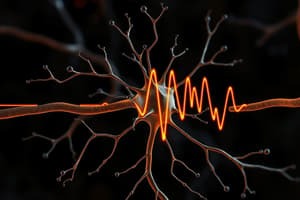Podcast
Questions and Answers
What is the typical resting membrane potential of a neuron?
What is the typical resting membrane potential of a neuron?
- -80
- -60
- -90
- -70 (correct)
What is the primary function of the sodium-potassium pump?
What is the primary function of the sodium-potassium pump?
- 3.5
- 3.7
- 3 (correct)
- 5.5
Which type of ion channels remain open during the resting potential of a neuron?
Which type of ion channels remain open during the resting potential of a neuron?
- 4
- 3
- 5
- 2 (correct)
Why is maintaining a resting potential important for neurons?
Why is maintaining a resting potential important for neurons?
How does the permeability of the neuron membrane affect ion movement during resting potential?
How does the permeability of the neuron membrane affect ion movement during resting potential?
Which ions are primarily affected by the neuron’s resting potential?
Which ions are primarily affected by the neuron’s resting potential?
What is the result of potassium channels being mostly closed during resting potential?
What is the result of potassium channels being mostly closed during resting potential?
Which of the following best describes glia cells?
Which of the following best describes glia cells?
What is the primary function of astrocytes in the brain?
What is the primary function of astrocytes in the brain?
Which type of glial cell is responsible for the production of myelin?
Which type of glial cell is responsible for the production of myelin?
How does the blood-brain barrier primarily protect the brain?
How does the blood-brain barrier primarily protect the brain?
Why is the blood-brain barrier crucial for health?
Why is the blood-brain barrier crucial for health?
What types of molecules can cross the blood-brain barrier passively?
What types of molecules can cross the blood-brain barrier passively?
Which cell type is involved in the immune response within the brain?
Which cell type is involved in the immune response within the brain?
What happens to the endothelial cells in the blood-brain barrier during Alzheimer's disease?
What happens to the endothelial cells in the blood-brain barrier during Alzheimer's disease?
Which of the following correctly describes Schwann cells?
Which of the following correctly describes Schwann cells?
Flashcards
Resting Potential
Resting Potential
The stable electrical difference across a neuron's membrane when it's not transmitting a signal; typically around -70 mV.
Sodium-Potassium Pump
Sodium-Potassium Pump
A protein that actively moves sodium ions out of and potassium ions into the neuron.
Selective Permeability
Selective Permeability
The ability of a membrane to allow certain molecules or ions to pass through more easily than others.
Resting Membrane Potential
Resting Membrane Potential
Signup and view all the flashcards
Glia Cells
Glia Cells
Signup and view all the flashcards
Sodium Ions
Sodium Ions
Signup and view all the flashcards
Potassium Ions
Potassium Ions
Signup and view all the flashcards
Neuron Membrane
Neuron Membrane
Signup and view all the flashcards
Astrocyte function
Astrocyte function
Signup and view all the flashcards
Oligodendrocyte function
Oligodendrocyte function
Signup and view all the flashcards
Schwann cell function
Schwann cell function
Signup and view all the flashcards
Microglia function
Microglia function
Signup and view all the flashcards
Blood-Brain Barrier (BBB) function
Blood-Brain Barrier (BBB) function
Signup and view all the flashcards
BBB necessity
BBB necessity
Signup and view all the flashcards
BBB mechanism (passive)
BBB mechanism (passive)
Signup and view all the flashcards
BBB mechanism (active)
BBB mechanism (active)
Signup and view all the flashcards
Study Notes
Resting Potential of a Neuron
-
Neurons maintain an electrical gradient, slightly more negative inside than outside.
-
This difference is called the resting potential.
-
The typical resting membrane potential is -70 mV.
-
Chloride channels are open, allowing ion passage.
-
Potassium channels are mostly closed.
-
Sodium channels are closed.
-
Sodium-potassium pump actively transports 3 sodium ions out and 2 potassium ions in.
-
This maintains a higher sodium concentration outside the cell.
-
ATP (adenosine triphosphate) is the energy source for this process.
-
Sodium ions are attracted to the negative interior but the concentration gradient opposes this.
-
The sodium channels are closed, slowing this ion movement.
-
Potassium ions face a similar challenge: electrical forces pulling them in, and the concentration gradient pushing them out.
-
Both forces work against each other.
Nerve Impulse - Resting Potential
- The resting potential allows rapid neuron response to stimuli
- Forces on sodium: Electrical and concentration gradients both push sodium in.
- Forces on potassium: Electrical forces pull in, concentration forces pull out.
Glia Cells
- Glia cells are another component of the nervous system.
- Glia cells have functions different from transmitting information.
- Glia are smaller but slightly more numerous.
- Different types perform different functions.
Blood-Brain Barrier
- The blood-brain barrier keeps many substances from entering the brain.
- Protects the brain's neurons, which cannot be easily replaced.
- Prevents viruses, bacteria, and harmful chemicals from entering.
- Some small, uncharged molecules can diffuse across.
- Transport mechanisms exist for essential molecules (e.g., glucose).
- Alzheimer's linked to blood brain barrier disruption.
- Hinders delivery of useful medications.
Studying That Suits You
Use AI to generate personalized quizzes and flashcards to suit your learning preferences.




